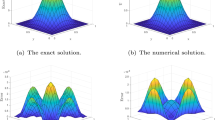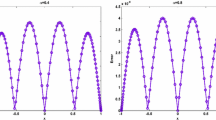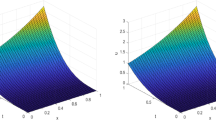Abstract
In the last decade, the analysis of time-space fractional Bloch–Torrey equation has been considered by different studies due to its applications in many fields. Since the analytical solution of this equation is difficult or impossible, numerical solutions can be helpful and sometimes are the only choice. Therefore, in this work, a numerical-based solution is shown by virtue of the Crank–Nicolson weighted shifted Grunwald difference method. The stability, as well as solvability of this method, are also investigated. It is shown that the method for time-space fractional Bloch–Torrey equation is of order \({\mathcal {O}}({\tau ^{2 - \alpha }},{h^2})\), where \(0<\alpha <1\). Also, \(\tau \) and h are the time step and space step, respectively. At the end, numerical applications are presented and the thrust of the present study is compared with other sophisticated schemes in the literature. The main advantage of the proposed scheme is that, it is more efficient in terms of accuracy and CPU time in comparing with the existing ones in open literature.








Similar content being viewed by others
References
Akgul EK (2018) A novel method for the space and time fractional Bloch–Torrey equations. Therm Sci 22:253–258
Azizi A, Abdi S, Saeidian J (2018) Applying Legendre wavelet method with Tikhonov regularization for one-dimensional time-fractional diffusion equations. Comput Appl Math 37:4793–4804
Baleanu D, Diethelm K, Scalas E, Trujillo JJ (2012) Fractional calculus models and numerical methods. World Scientific, Singapore
Butzer PL, Wefon R (1972) On the Lax equivalence theorem equipped with orders. J Approx Theory 19:239–252
Celik C, Duman M (2012) Crank–Nicolson method for the fractional diffusion equation with the Riesz fractional derivative. J Comput Phys 231:1743–1750
Dehghan M, Abbaszadeh M, Mohebbi A (2016) Analysis of a meshless method for the time fractional diffusion-wave equation. Numer Algorithms 4:445–476
Erfanifar R, Sayevand K, Ghanbari N, Esmaeili H (2021) A modified Chebyshev \(\vartheta \)-weighted Crank–Nicolson method for analyzing fractional sub-diffusion equations. Numer Methods Partial Differ Equ 37(1):614–625
Hou T, Tang T, Yang J (2017) Numerical analysis of fully discretized Crank–Nicolson scheme for fractional-in-space Allen–Cahn equations. J Sci Comput 72:1214–1231
Ingo C, Magin RL, Colon-Perez L, Triplett W, Mareci TH (2014) On random walks and entropy in diffusion weighted magnetic resonance imaging studies of neural tissue. Magn Reson Med 71:617–627
Jafari H, Firoozjaee MA, Johnston SJ (2020) An effective approach to solve a system fractional differential equations. Alex Eng J 59(5):3213–3219
Jinji N (2014) Comparative statics for oligopoly: a generalized result. Econ Lett 124(1):79–82
Kazem S, Dehghan M (2019) Semi-analytical solution for time-fractional diffusion equation based on finite difference method of lines (MOL). Eng Comput 35(1):229–241
Kilbas A, Srivastava HM, Trujillo JJ (2006) Theory and applications of fractional differential equations. Elsevier, Amsterdam
Kincaid D, Cheney W (1991) Numerical analysis. Brooks/Cole Publishing, California
Kumar S, Faraz N, Sayevand K (2014) A Fractional model of Bloch equation in nuclear magnetic resonance and its analytic approximate solution. Walailak J Sci Technol 11(4):273–285
Lin FR, Wang QY, Jin XQ (2020) Crank–Nicolson-weighted-shifted-Grünwald-difference schemes for space Riesz variable-order fractional diffusion equations. Numer Algorithms 363:77–91
Liu F, Feng L, Anh V, Li J (2019) Unstructured-mesh Galerkin finite element method for the two-dimensional multi-term time-space fractional Bloch–Torrey equations on irregular convex domains. Comput Math Appl 78(5):1637–1650
Magin RL, Abdullah O, Baleanu D, Zhou XJ (2008) Anomalous diffusion expressed through fractional order differential operators in the Bloch–Torrey equation. J Magn Reson 190:255–270
Magin RL, Hall MG, Karaman MM, Vegh V (2020) Fractional calculus models of magnetic resonance phenomena: relaxation and diffusion. Crit Rev Biomed Eng 48:285–326
Meerschaert MM, Tadjeran C (2004) Finite difference approximations for fractional advection-dispersion flow equations. J Comput Appl Math 172(1):65–77
Nikan O, Avazzadeh Z, Tenreiro Machado JA (2020) Numerical investigation of fractional nonlinear sine-Gordon and Klein–Gordon models arising in relativistic quantum mechanics. Eng Anal Bound Elem 120:223–237
Nikan O, Avazzadeh Z, Tenreiro Machado JA (2021a) An efficient local meshless approach for solving nonlinear time-fractional fourth-order diffusion model. J King Saud Univ Sci. https://doi.org/10.1016/j.jksus.2020.101243
Nikan O, Avazzadeh Z, Tenreiro Machado JA (2021b) Numerical approximation of the nonlinear time-fractional telegraph equation arising in neutron transport. Commun Nonlinear Sci Numer Simul. https://doi.org/10.1016/j.cnsns.2021.105755
Nikan O, Tenreiro Machado JA, Golbabai A, Rashidinia J (2021c) Numerical evaluation of the fractional Klein–Kramers model arising in molecular dynamics. J Comput Phys. https://doi.org/10.1016/j.jcp.2020.109983
Ortigueira MD (2006) Riesz potential operators and inverses via fractional centred derivatives. Int J Math Math Sci 2006:048391. https://doi.org/10.1155/IJMMS/2006/48391
Ortigueira MD (2011) Fractional calculus for scientists and engineers. Springer, Berlin
Qin S, Liu F, Turner IW, Yang Q, Yu Q (2018) Modelling anomalous diffusion using fractional Bloch–Torrey equations on approximate irregular domains. Comput Math Appl 75(1):7–21
Samko SG, Kilbas A, Marichev O (1993) Fractional integrals and derivatives: theory and applications. Gordon and Breach, Langhorne
Sayevand K, Machado JT, Moradi V (2019) A new non-standard finite difference method for analyzing the fractional Navier–Stokes equations. Comput Math Appl 78(5):1681–1694
Sun Z, Wu X (2006) A fully discrete difference scheme for a diffusion-wave system. Appl Numer Math 56(2):193–209
Sun H, Sun ZZ, Gao GH (2016) Some high order difference schemes for the space and time fractional Bloch–Torrey equations. Appl Math Comput 281:356–380
Tajadodi H, Kadkhoda N, Jafari H (2020) Approximate technique for solving fractional variational problems. Pramana 94(1):1–8
Tarasov VE (2011) Fractional dynamics: applications of fractional calculus to dynamics of particles, fields and media. Springer, Berlin
Tian W, Zhou H, Deng W (2015) A class of second order difference approximations for solving space fractional diffusion equations. Math Comput 84(294):1703–1727
Van Nguyen D, Li JR, Grebenkov D, Le Bihan D (2014) A finite elements method to solve the Bloch–Torrey equation applied to diffusion magnetic resonance imaging. J Comput Phys 263:283–302
Zhuang P, Liu F, Anh V, Turner I (2009) Stability and convergence of an implicit numerical method for the non-linear fractional reaction-subdiffusion process. IMA J Appl Math 74(5):645–667
Acknowledgements
The authors wish to express their cordial thanks to the editor and three anonymous referees for useful suggestions and comments.
Author information
Authors and Affiliations
Corresponding author
Additional information
Communicated by José Tenreiro Machado.
Publisher's Note
Springer Nature remains neutral with regard to jurisdictional claims in published maps and institutional affiliations.
Rights and permissions
About this article
Cite this article
Sayevand, K., Ghanbari, N. & Masti, I. A robust computational framework for analyzing the Bloch–Torrey equation of fractional order. Comp. Appl. Math. 40, 131 (2021). https://doi.org/10.1007/s40314-021-01513-7
Received:
Revised:
Accepted:
Published:
DOI: https://doi.org/10.1007/s40314-021-01513-7
Keywords
- Time-space fractional Bloch–Torrey equation
- Crank–Nicolson method
- Grunwald difference operators
- Error analysis




